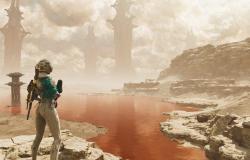
Monday morning, the planets will be aligned, and it’s not just an expression. Just before sunrise, six stars from our solar system will form a line in the sky from Earth: Jupiter, Mercury, Uranus, Mars, Neptune and Saturn, in that order. An event that occurs “about once every year or every two years,” specifies Eric Lagadec, astrophysicist at the Côte d’Azur Observatory and author of The Cosmic Odyssey. An intimate history of the starspublished in 2023 by Seuil editions.
Clicking on” I accept “you accept the deposit of cookies by external services and will thus have access to the content of our partners.
More information on the Cookie management policy page
I accept
The stardust specialist posted on X, Friday May 24, a thread on the phenomenon, “to avoid there being false beliefs”, he explains to 20 minutes. The subject is in fact more difficult than it seems, because what we will be able to observe from Earth does not correspond to the reality of the arrangement of the planets around the Sun. “If we placed ourselves above the solar system, we would not see the planets aligned,” explains the astrophysicist.
A question of point of view
If the planets appear in a line, it is firstly because they “rotate around the Sun in the same plane”, that is to say that “none rotates perpendicular to another”. Therefore, seen from Earth, the planets of the solar system “pass the same place in the sky”, from east to west, like the Sun and the Moon, and “their apparent trajectory follows a straight line, which we call the ecliptic.
“It’s simply due to the rotation of the Earth,” says Eric Lagadec. We will be able to see as many aligned on Monday because, seen from Earth, they “are on the same side of the Sun”, in addition to being “oriented in a way that we see them all at the same time” of the night .
Not so easy to see
If the six planets will, in theory, be clearly visible at the same time in the sky, the stardust specialist remains cautious: “Some will be difficult to see”. Saturn and Mars “will be easily visible to the naked eye, even in the city.” They can be identified because they will appear as “the brightest points in the sky” when looking east.
On the other hand, you will need to be equipped with a telescope to see Neptune and Uranus participating in the parade, because “they are invisible to the naked eye”. As for Mercury and Jupiter, although it will a priori be possible to observe them without equipment, “it is not certain that we will see them very well, because they will be very close to the Sun and will rise just before it” and be quickly “drowned in its light”.
For the curious who would like to attend the show, some practical advice from Eric Lagadec: “You will have to look at the sky a little before sunrise”, the time of which depends on where you are in France. “There can be an hour difference between Nice and Brest! », Specifies the astrophysicist. The most important thing is to “find a clear horizon to the east”, because that is where the planets will rise. Last step, and not least: “Enjoy!” It’s always good to look at the sky. » And there should be enough to have, literally, stars in your eyes.





